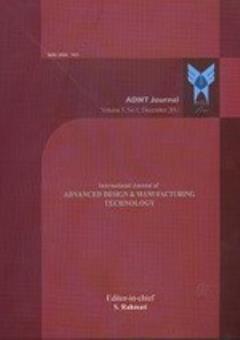Numerical Analysis of Fluid-Structure Interaction in The Aortic Arch Considering Various Blood Flow Rates
Subject Areas : Mechanical EngineeringHamid Zandvakili 1 , Kamran Hasani 2 * , Syamak Khorramymehr 3
1 - PhD candidate Science and Research branch, Islamic Azad University, Iran
2 - Associate Professor, Science and Research branch, Islamic Azad University, Iran
3 - Science and Research branch, Islamic Azad University, Iran
Keywords: Aortic Arch, FSI Method, Hemodynamics, Numerical Modeling, Perfusion,
Abstract :
Hemodynamic forces are felt by the biomechanical receptors of the arterial wall to give an appropriate response to maintain homeostasis. On the other hand, baroreceptors are a type of biomechanical receptors that are sensitive to abnormal stretch sizes. It is very important to predict the distribution of stress and strain caused by the hemodynamic field to the vessel wall in pressure-sensitive areas to evaluate the function of these receptors. In the present study, a three-dimensional (3-D) model of the aortic arch is presented. The geometry was reconstructed based on the CT images. Also, numerical analysis was performed using the fluid-structure interaction method. First, the hemodynamic field containing the pressure and velocity distribution in the blood area was obtained. Then, the deformation and stress fields in the solid domain were analyzed. The results show that the highest vertical stress occurs in the posterior supra aorta. So, the amount of this maximum vertical stress increases up to 5 kPa in some places; these points have higher tensions, and they can be susceptible to rupture and aneurysm diseases. Higher normal stress happened at the aortic root and the supra-aortic branches and reached approximately 200 kPa at Peak Systole. Also, the highest amount of strain occurs in the posterior supra aorta, reaching 0.001.
[1] Donald, D. E., Edis, A. J., Comparison of Aortic and Carotid Baroreflexes in the dog, J. Physiol, Vol. 215, No. 2 1971, pp. 521-38, Doi: 10.1113/jphysiol. 1971.sp009483.
[2] Feng, B., Li, B. Y., Nauman, E. A., and Schild, J. H., Theoretical and Electrophysiological Evidence for Axial Loading About Aortic Baroreceptor Nerve Terminals in Rats, Am J Physiol Heart Circ Physiol, Vol. 293, No. 6, 2007, pp. 3659-72.
[3] Carlson, B. E., Arciero, J. C., and Secomb, T. W. Theoretical Model of Blood Flow Autoregulation: Roles of Myogenic, Shear-Dependent, And Metabolic Responses, American Journal of Physiology-Heart and Circulatory Physiology, Vol. 295, No. 4, 2008, pp. 1572-1579,
[4] Rizzo, D. C., Fundamentals of Anatomy and Physiology, Cengage Learning, 2015.
[5] Bisognano, J., Sloand, J., Papademetriou, V., Rothstein, M., Sica, D., Flack, J., and Cody, R. J., An Implantable Carotid Sinus Baroreflex Activating System for Drug-Resistant Hypertension: Interim Chronic Efficacy Results from The Multi-Center Rheos Feasibility Trial, 2006.
[6] Kroon, A., Schmidli, J., Scheffers, I., Tordoir, J., Mohaupt, M., Allemann, and De Leeuw, P., Sustained Blood Pressure Reduction by Baroreflex Activation Therapy with A Chronically Implanted System: 4-Year Data of Rheos Debut-Ht Study in Patients with Resistant Hypertension: 9D. 01, Journal of Hypertension, Vol. 28, No. 441, 2010.
[7] Lee, S. W., Antiga, L., Spence, J. D., and Steinman, D. A., Geometry of the Carotid Bifurcation Predicts Its Exposure to Disturbed Flow, Stroke Vol. 39, No. 8, 2008, pp. 2341–7.
[8] Dong, J., Wong, K. K. L., and Tu, J., Hemodynamics Analysis of Patient‐Specific Carotid Bifurcation: a CFD Model of Downstream Peripheral Vascular Impedance, Int J Numer Method Biomed Eng, Vol. 29, No. 4, 2023, pp. 476–91.
[9] Suito, H., Takizawa, K., Huynh, V. Q. H., Sze, D., and Ueda, T., FSI Analysis of The Blood Flow and Geometrical Characteristics in The Thoracic Aorta, Comput Mech, Vol. 54, No. 4, 2022, pp. 1035–45.
[10] Lantz, J., Renner, J., and Karlsson, M., Wall Shear Stress in A Subject Specific Human Aorta—Influence of Fluid-Structure Interaction. Int. J. Appl Mech, Vol. 3, No. 04, 2021, pp. 759–78.
[11] Crosetto, P., Reymond, P., Deparis, S., Kontaxakis, D., Stergiopulos, N., and Quarteroni, A., Fluid–Structure Interaction Simulation of Aortic Blood Flow. Comput Fluids, Vol. 43, No. 1, 2021, pp. 46–57.
[12] Klabunde, R., Cardiovascular Physiology Concepts, Lippincott Williams & Wilkins, 2011.
[13] Kougias, P., Weakley, S. M., Yao, Q., Lin, P. H., and Chen, C., Arterial Baroreceptors in The Management of Systemic Hypertension, Med Sci Monit Int Med J Exp Clin Res, Vol. 16, No. 1, RA1, 2010.
[14] Gabe, I. T., Gault, J. H., Ross, J. Jr., Mason, D. T., Mills, C. J., Schillingford, J. P., and Braunwald, E., Measurement of Instantaneous Blood Flow Velocity and Pressure in Conscious Man with A Catheter-Tip Velocity Probe, Circulation, Vol. 40, No. 5, 1969, pp. 603-14.
[15] James, M. E., Papavassiliou, D.V., and O’Rear, E. A., Use of Computational Fluid Dynamics to Analyze Blood Flow, Hemolysis and Sublethal Damage to Red Blood Cells in a Bileaflet Artificial Heart Valve, Fluids, Vol. 4, No. 19. 2019, https://doi.org/10.3390/fluids4010019.
[16] Vinoth, R., Kumar, D., Raviraj, A., and Vijay Shankar C. S., Non-Newtonian and Newtonian blood flow in human aorta: A transient analysis, Biomedical Research (India), Vol. 28, 2016.
[17] Giannakoulas, G., Giannoglou, G., Soulis, J., Farmakis, T., Papadopoulou, S., Parcharidis, G., and Louridas, G., A Computational Model to Predict Aortic Wall Stresses in Patients with Systolic Arterial Hypertension, Med Hypotheses, Vol. 65, No. 6, 2005, pp. 1191-5, Doi: 10.1016/j.mehy.2005.06.017. Epub 2005 Aug 16. PMID: 16107302.
[18] Kass, J. S., Mizrahi, E. M., Neurology Secrets E-Book. Elsevier Health Sciences, 2016.
[19] Heesch, C. M, Reflexes that Control Cardiovascular Function, Adv Physiol Edu, Vol. 277, No. 6, 1999, pp. 234.
[20] Klabunde, R., Cardiovascular Physiology Concepts, Lippincott Williams & Wilkins, 2011, pp. RA1–8.
[21] Kougias, P., Weakley, S. M., Yao, Q., Lin, P. H., and Chen, C., Arterial Baroreceptors in The Management of Systemic Hypertension, Med Sci Monit Int Med J Exp Clin Res, Vol. 16, No. 1, 2010, RA1.

